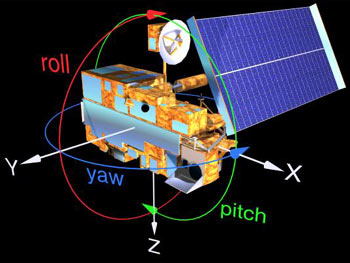

The Unplanned Roll |
|||
Throughout the course of its (at minimum) 6-year lifetime, there is a series of maneuvers planned for Terra. These maneuvers fall into two categories: (1) attitude maneuvers that involve changing the orientation of the spacecraft in any of three possible axes (called roll, pitch, and yaw); and (2) orbital maneuvers that involve changing either the orbital altitude or the orbital plane of the satellite in order to adjust the local time at which Terra crosses the equator. There are "thrusters" positioned strategically at locations on the
spacecraft that allow the flight operations team to adjust the orbital position
of Terra–to fly it, essentially. Onboard tanks contain hydrazine, a
reactive gas commonly used on spacecraft. In firing the thrusters, the ground
operations team is actually releasing some hydrazine from the tank and routing it
over a heated catalyst that breaks down the gas into products that are forced out
through small rocket engines, thereby providing thrust for the spacecraft. |
|||
 |
Throughout its lifetime, Terra will periodically perform a variety of attitude maneuvers for calibration purposes. In these maneuvers, Terra changes its orientation with respect to the Earth. The spacecraft will pivot on one or more of three possible axes to enable its sensors to view the blackness of deep space or the moon. Spinning on its X-axis is called a “roll”; spinning on its Y-axis is a “pitch”; and spinning on its Z-axis is a “yaw” maneuver. (Image by Reto Stockli) | ||
The first major maneuver planned for Terra, on January 11, was to raise it from its lower elliptical orbit to a higher, circular orbit of 705 km above the Earth. The flight operations team had to meet the requirement of flying in formation with Landsat 7 so that Terra descends across the equator at roughly 10:30 a.m. local time, about 15 minutes behind Landsat 7 on the same flight path. To do this orbital maneuver, the Terra team had to fire Terra’s onboard thrusters to both raise its orbit as well as keep the satellite properly oriented with respect to the Earth. At 6:19 p.m. EST, the team began firing the thrusters. Moments later Terra’s flight computer aborted the maneuver when it correctly diagnosed that Terra was beginning to roll more than expected. "I was in the mission control room and was growing very concerned about the increasing roll rate," Quinn recounts. "At the time, I didn’t have an explanation of why Terra was rolling." Quinn’s mind raced as he watched Terra enter "safe mode." There are two separate protective programs built into the spacecraft to limit how much error is allowed in its orientation. If any error limits are exceeded, then the thrusters stop firing automatically and the protective programs take over to re-establish Terra into an Earth-pointing orientation. In this way, if the ground controls fail for any reason, the sensors will by default be pointed at the Earth and the mission’s science objectives can still continue safely. Again, Grady scrambled his flight operations team into a brainstorming session
that lasted, off and on, for a couple of weeks. Why did Terra begin an unplanned
roll when they started boosting its orbit? After many days filled with long
hours of exhaustive work examining all the possibilities, and creating and
modifying computer models of the spacecraft’s behavior, the team narrowed
the list of possibilities to a few key suspects. |
|||
Grady’s team determined that the roll was caused by a combination of two things: (1) a misalignment in the satellite’s center of gravity with respect to the thruster settings, and (2) plumes from two of the thrusters impinging on the solar array. "There is a ‘thruster pairing matrix’ that resides in the software system aboard the spacecraft that describes how much torque you get from each thruster," Grady elaborates. "When the control system needs a certain amount of torque, it uses that matrix to decide which thrusters to fire to get the desired thrust. We discovered that these thruster pairing matrices weren’t exactly correct for the center of gravity of the spacecraft, but we knew we’d have to fine-tune the matrices on orbit." What Grady and his team hadn’t known is that the gas molecules escaping the thrusters on the rear of the spacecraft would spread out into a cone shape so that enough of these molecules would impact the solar panel with an effective force of approximately one-quarter of a pound. (View an animation [6.2MB] of exhaust gasses hitting Terra's solar panel) "At 30 feet long, what you basically have with the solar array is a very long moment arm, or lever, on the spacecraft," he explains. "Even though Terra weighs approximately 11,000 pounds, the solar panel gives you such a long lever that it doesn’t take much force on the end of it to roll the spacecraft." After days of analyzing telemetry data and conducting simulations that nearly identically matched Terra’s behavior, Grady and his team were convinced that they understood the problem well enough to resume the ascent maneuver. This time, they did two things to avoid another unplanned roll: (1) they fine-tuned the thruster pairing matrices to more precisely account for the satellite’s center of gravity and external disturbances generated by the thruster plumes, and (2) they placed the solar array into a position where it would minimize any impingement from thruster plumes. They began the ascent with a series of short thruster bursts and once they knew they had solved the problem, they did a series of longer thrusts. Terra reached its target orbital altitude on February 23 and its sensors began opening their aperture doors the next day for science operations. Terra’s activation had begun. |
 During the first maneuver to raise Terra into its final orbit the spacecraft rolled excessively. Using computer simulations, the mission controllers discovered that exhaust from a rocket thruster was pushing on Terra's large solar panel. (Image and animation by Reto Stöckli [6.2MB]) |